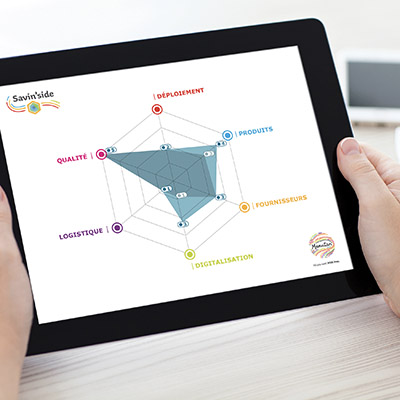In the face of increased competition, companies are seeking to improve their operations, enhance efficiency and boost competitiveness. To achieve this, they can leverage a key Lean Management tool: Value-Stream Mapping (VSM). This value chain mapping serves as a strategic lever to precisely optimise operations within the company. It falls to procurement teams to embrace it to eliminate waste, rationalise their processes and promote continuous improvement.
What is Value-Stream Mapping?
Value-Stream Mapping (VSM) is a visual tool that involves mapping all physical and information flows within a company. The objective: To conduct an analysis on current processes with a focus on continuous improvement.
VSM is an integral part of Lean Management. As such, this tool aims to eliminate all waste to optimise value for the end customer. In practical terms, this mapping can help companies better visualise their working methods and identify areas for improvement to enhance efficiency.
As management guru Peter Drucker notes: "There is nothing so useless as doing efficiently that which should not be done at all." This is precisely what VSM is about: Focusing on value-added activities.
As a particularly cross-functional department, procurement has everything to gain from using such a structured approach. VSM offers a holistic approach to the Source-to-Pay process, from identifying needs to the delivery of goods and/or services.
Key VSM steps
VSM is organised into five main steps, from project scoping to drawing up an implementation plan with corrective actions.
Step 1: Selecting the observed flow
This first step involves defining the mapping scope. You must specify which element’s flow you want to track. This can be a procurement request or product manufacturing, for example. The relevant flow will be tracked in detail until the finished product and/or service is delivered to the end customer. It’s important to clearly define a start and end point for the flow to be mapped at the outset.
Step 2: Drawing the current state
This second step involves mapping the current state of the value stream. It requires analysing the current situation to create a diagnosis as close to reality as possible. Creating this current state map involves conducting field observations to identify, describe and document each process step. It’s essential to specify the category, quantity of units involved, cycle time, distance travelled… Then comes the visual representation of the flows, which includes using appropriate colours and symbols specific to this method. This provides a snapshot of the current process situation, with all its problems.
Step 3: Identifying waste
This third step focuses on analysing the overall process mapping to identify waste sources and areas for improvement. The data associated with each step enables interesting calculations:
- Flow lead time;
- Total processing and control time;
- Total distance;
- Ratio between total processing time;
- Lead times;
- Etc.
This exercise highlights all waste throughout the value stream.
-
Overproduction, producing too much or too early;
-
Overstocking or unnecessary stock;
-
Unnecessary transport and movement of raw materials, documents, information…;
-
Unnecessary processing or "overprocessing", which amounts to over-quality;
-
Errors, defects and scrap, in other words, non-quality;
-
Waiting times to obtain information, complete tasks…;
-
Unnecessary personnel movements that are excessive or non-ergonomic.
Step 4: Creating the vision
The fourth step focuses on designing the future state of the value stream. Creating this future state map involves visually representing a "target" flow that remains fictional initially. This new mapping takes into account all the areas for improvement the company plans to work on. All optimised processes are described here. When implemented effectively, this should lead to better performance and greater customer satisfaction.
Step 5: Implementing improvements
The fifth and final step focuses on deploying improvement initiatives. These may include:
- Eliminating duplicate tasks;
- Rethinking the validation workflow;
- Building operating standards;
- Improving service meetings;
- Training teams on new procedures;
- Etc.
Their execution must be planned, implemented and finally measured for impact, as part of the Lean approach.
The benefits of VSM for the procurement function
Through this value stream mapping, procurement teams gain in overall performance. Such an overview allows them to improve their operational efficiency while aligning more closely with the company’s overall strategy.
Making informed decisions
First, VSM provides valuable information about the procurement process. This enables procurement teams to make data-driven decisions based on field observations. This then translates into informed choices about production process optimisation, as well as related topics such as team training, visual management and digital tools.
Reducing costs
In parallel, VSM allows companies to identify cost-saving opportunities. By eradicating tasks without added value, optimising resources and rationalising supply chain processes, they reduce both their direct and indirect costs. This contributes to these companies’ financial results, giving them a significant competitive advantage going forward.
Improving stakeholder relationships
VSM encourages companies to increase collaboration between various stakeholders. This concerns both company departments (procurement, supply, logistics…) and suppliers. By optimising information flows, this strengthens transparency, communication and coordination between everyone. This approach ultimately promotes the development of mutually beneficial relationships.
Value-Stream Mapping (VSM) is therefore a powerful lever for optimising processes and achieving operational excellence in procurement. This is how companies can stay ahead of the market and continue to deliver more value to their customers.









